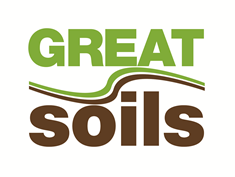Using a variety of assessment methods to test the health of soils, rather than relying on just standard nutrient testing, could reward growers with higher yields and greater profitability by helping make better informed management decisions on farm.
Many growers will regularly test crop nutrient availability to inform fertilising programmes, but this is only one basic step towards understanding the potential of soils.
Using a wider range of soil evaluation methods, including investigations into soil structure, soil organic matter and biology, will give a better indication of soil health and therefore help to improve farm-management decision making.
Growers attending a GREATsoils event at Honeydale Farm in the Cotswolds in June were shown simple and easy to use soil health testing methods that can be done by growers in the field.
Dr Martin Wood, from Earthcare Technical who led the workshop said: “Soil health is as much about biology and structure as it is about the chemical composition. There are lots of simple testing methods that can measure soil health and we would urge growers to have a go at these and see what works for their growing systems.
“No one test is better than another and no one test will give you all the information you need to build a clear picture of your soil health.”
Factors which affect soil health include physical parameters such as soil structure; chemical parameters such as crop nutrient indices and soil organic matter content and biological parameters such as earthworm numbers. These can all be affected by the ways in which we manage our soils.
There is a range of soil assessment methods which vary in complexity, time input and skill. Some tests can be run by growers on farm, including earthworm counts, water infiltration and visual soil assessment using a spade. More adventurous growers could try out simple soil respiration and aggregate stability tests. Other assessments require laboratory testing, including soil organic matter and nutrient availability tests.
Iain Tolhurst from Tolhurst Organic C.I.C who are looking at green manures as part of GREATsoils field work trials said: “The earthworm counting is a great way to assess soil health and one that can be learnt quickly by growers. I’m particularly interested in the respiration test we’ve been doing in this trial and the measuring of soil organic matter as it brings a more academic approach to the testing.”
Grace Choto, knowledge exchange manager at AHDB said: “The GREATsoils programme is informing and demonstrating the value of healthy soils to businesses through reduced input costs from fertilisers and irrigation use, to increased yields from healthier crops.“
GREATsoils (Growing Resilient, Efficient and Thriving Soils) is a programme funded by AHDB Horticulture to inspire and support growers to assess and manage the health of their soils.
There are lots of GREATsoils events planned around the UK throughout 2017. To find out more and to book your place, visit horticulture.ahdb.org.uk/GREATsoils
An information sheet is also available for growers which outlines soil assessment methods to download from horticulture.ahdb.org.uk/GREATsoils




